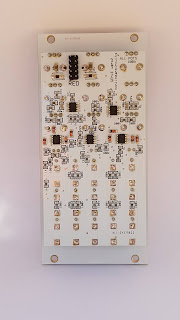It can be built to run at different speeds simply by installing different capacitors. Very easy build, no special components needed.
There are 5 different CV outputs and 1 gate output. The CV IN is associated with the CLIMAX pot which determines how high the peaks go. The module can be greatly influenced by the CV in signal and can exhibit some fairly nutty responses at times.
IN1 and IN2 are the inputs for the Signum switch, they are also connected via their switching pins to the internal workings of the hyperchaos circuit. SW2 is also the internal switch for the hyperchaos circuit so if you use this input you will find that switching only occurs with an external signal. Use SW1 if you want to control the switching of the hyperchaos with an external signal.
As ‘signum’ implies, the switching signal is +1 or -1. This means you need a signal crossing 0 to make switching occur. A regular gate may or may not work, depending whatever else is going on at the time. The signum output is also the W output, as indicated on the panel.
Build guide & panel template




















































